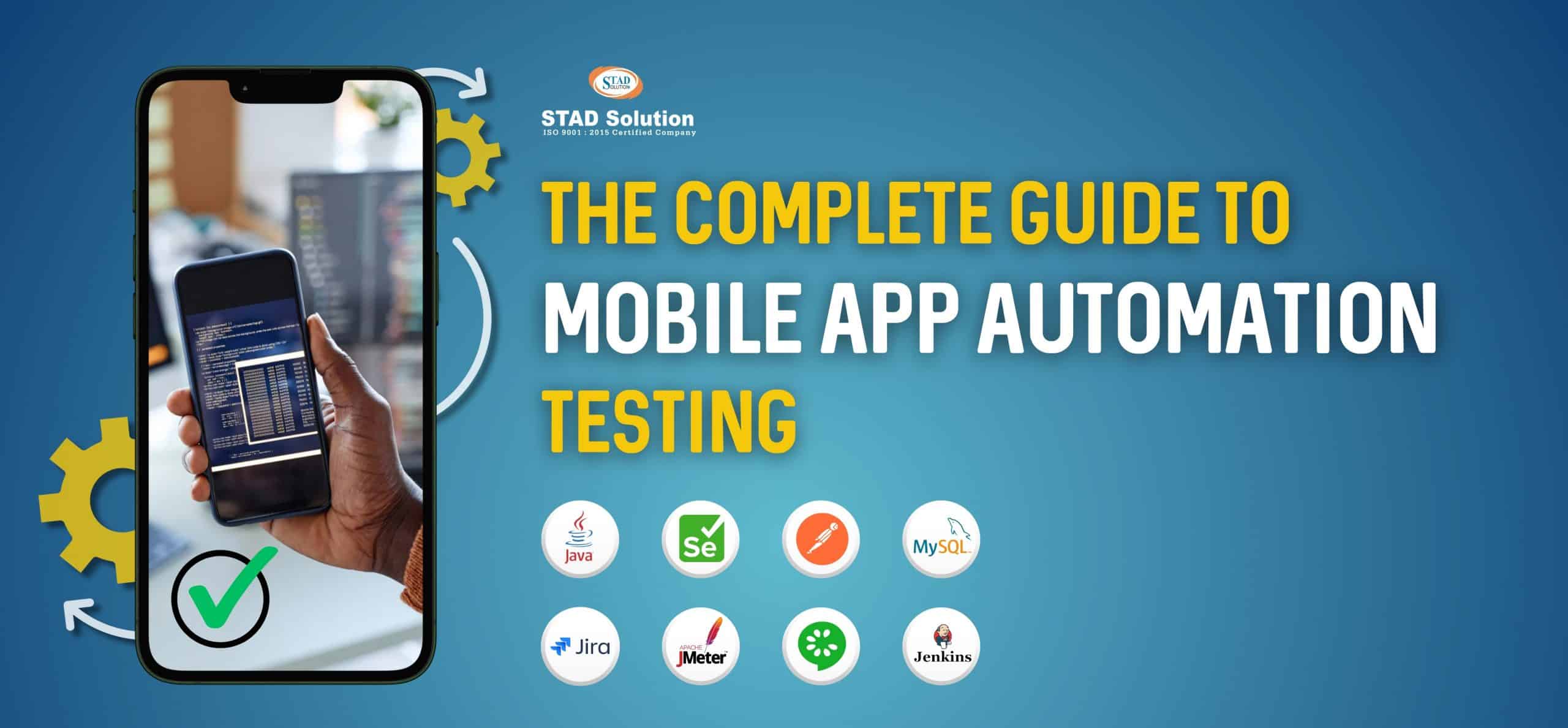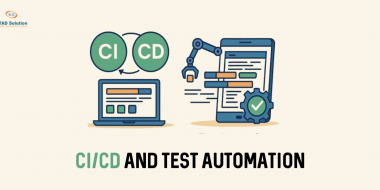
Mobile app automation testing is the basic foundation of any successful mobile application, ensuring high-quality features and flawless performance. Mobile applications have evolved into a necessity for daily use and serve a broad range of purposes, such as online shopping, finance management and social media.
Today, with a staggering 6.9 billion smartphone users worldwide, the pressure on developers to deliver top-quality and dependable mobile apps has reached an all-time high. The application must be good enough to stay in competition with other apps having similar features. However, these apps function across an enormous range of devices with different operating systems, and the developers require more than just manual testing.
This is where mobile app automation testing comes into the picture. For those eager to dive even deeper and gain hands-on experience, Stad Solution’s software testing course offers expert-led training designed to help you become proficient in automation testing.
What is Mobile App Automation Testing?
Mobile app automation testing involves using one of many available tools to monitor, test, and update the app features to get the best functionality, performance, scalability, and usability of an application. Unlike manual testing, mobile app testing automation uses scripts to complete repetitive tasks. These scripts include interactions with the components of the mobile app, like tapping, swiping, typing, checking functionality, and running environment. It’s a game changer for meeting market demands with great precision.
How Automated Testing Differs from Manual Testing?
Aspect | Automated Testing | Manual Testing |
Execution | With scripts and tools automatically. | A human tester tests step by step. |
Speed | Faster and run tests simultaneously and repeatedly. | Slower, skill-based testing depending on the tester. |
Accuracy | More accurate and follows predefined steps with less human error. | Likely more prone to human error with repetition.. |
Coverage | Can cover a large number of test cases and complex scenarios quickly. | Depending on the tester, it is limited by their capacity and time. |
Cost | Automated testing requires a higher initial investment for tools, script development, but it stays cost-effective in the long run. | Manual testing lowers upfront costs but can be expensive over time due to continuous human effort. |
Suitable Test Types | Regression, performance, and load testing. | Better for exploratory, usability, and ad-hoc testing. |
Maintenance | Updating scripts with application changes. | No script maintenance. |
Why Choose Automate Mobile App Testing?
Mobile app automation testing transforms whole application development with unmatched benefits and accuracy. Here is why anyone needs to choose mobile app automation testing:
Key Benefits
- Rapid Testing: Accelerating the testing phase and faster release cycles in app development.
- Non-Stop Execution: Scripts can work anytime and can be scheduled to run at any hour of the day, with diverse real-world test cases.
- Broad Coverage: With automaton, it is possible to generate complex scenarios that can rarely occur but can hinder application progress and user trust.
- Script Resuability: Saves time across different updates.
- Early Bug Detection: speeds up the bug finding and fixing rate with automated mobile testing tools.
- Instant Feedback: Developers can get real-time insights at any stage.
- Precision: reduces human error in repetitive tasks.
- Cost and Time Efficient: Automation testing cuts labour cost, and the task is divided into intervals, important for staying competitive.
Real-World Impact
Research from the industry highlights that automation can slash testing time by as much as 50%, enabling faster release cycles and cutting down on overall development cost. Major companies like Uber, Airbnb, and Spotify have embraced automation as a basis of their testing strategies, relying on it to maintain exceptional quality standards while pushing out frequent updates to millions of users.
Types of Mobile App Automation Testing
Below are the comprehensive mobile app automation tests based on application stages.
- Functional Testing: This ensures features work via automated mobile app testing, with basic actions like logging in with ID and password to complex tasks like online purchase or chat.
- Performance Testing: Here, the speed and scalability of the mobile app are tested, focused on the user’s perspective.
- Usability Testing: Based on UI/UX testing, replicating real-world user interactions.
- Security Testing: Protects data with automated security testing. It includes identifying vulnerabilities, data breaches, weak encryption detection and flawed login system detection.
- Compatibility Testing: Conifers cross-device performance, including screen resolutions and OS versions, to get a uniform and reliable final product.
Top Mobile App Automation Testing Tools in 2025
Here is a detailed comparison of the best mobile app automation testing tools.
Tool | Platform | Key Features | Pros | Cons |
iOS, Android | Cross-platform, multi-language support | Free, versatile | Slower, complex setup | |
Espresso | Android | Fast, native app testing | Reliable, Google-supported | Android-only |
Calabash | iOS, Android | Native/hybrid app support | Multi-language, parallel | Less active development |
NightwatchJS | iOS, Android | Simple, parallel testing | JavaScript-friendly | Smaller community |
XCUITest | iOS | High-performance, native testing | Quick, Xcode integration | iOS-only, Swift needed |
How to Choose the Right Tool?
Selecting the best tool is a critical step in achieving successful automation, as the right choice can significantly enhance your testing efficiency and effectiveness. But which automation testing tool works the best?
Appium stands out as an excellent choice due to its robust cross-platform support, allowing you to write a single set of tests for both systems. If you’re developing an Android-only app, Espresso provides a fast and dependable option with strong backing from Google, making it ideal for native Android development. For teams comfortable with JavaScript, NightwatchJS offers an approachable entry point with its straightforward setup and Appium integration.
To gain a deeper understanding of these tools and how to apply them effectively, Stad Solution’s software testing course provides practical training that can accelerate your learning curve and boost your confidence.
Step-by-Step Guide to Setting Up Mobile App Automation Testing
1. Define Your Testing Goals
To start with, one can decide what they need to achieve with automation. For example, if a developer wants to check the functionality (e.g., login and sign-up), performance (like app speed), or usability. So the goal can be clear, which helps in choosing the right tool.
- Example: Automate login tests if your app gets frequent updates.
2. Choose a Testing Tool
Pick a tool that matches the app and team’s needs. Popular options include:
- Appium: Great for iOS and Android with one script.
- Katalon: Easy for beginners with low-code features.
If unsure, see the Stad Solution’s automation testing course to explore tools and hands-on practice.
3. Set Up Your Environment
Prepare your testing setup, which includes the following:
- Emulators: Test early versions cheaply.
- Real Devices: Use for final checks (e.g., via cloud services like BrowserStack).
- Tip: Mix both for best results.
4. Write Test Scripts
Create scripts to automate your tests:
- Start with simple cases (e.g., entering a username).
- Use record-and-playback features if available.
- Keep scripts modular for easy updates.
5. Run and Review Tests
Execute your tests and check the results:
- Schedule tests to run automatically.
- Look at reports to spot issues fast.
- Integrate with tools like Jenkins for continuous testing.
6. Maintain Your Tests
Keep your automation current:
- Update scripts when the app changes.
- Review regularly to ensure coverage.
- Maintenance is key to long-term success.
Want to dive deeper? Stad Solution’s automation testing course offers practical training to perfect your mobile app automation skills. Enroll today!
Best Practices for Mobile App Automation Testing
Maximize the mobile app automation testing with these best practices:
- Design Testable Apps: The key is to collaborate closely with developers during the app design phase and ensure all workable interactive elements like buttons, text fields, menus and backend data handling.
- Use Simple Selectors. When writing any automated testing script, one must prioritize selectors like element IDS or accessibility labels over complex options like XPath, which can slow down execution.
- Use Real Devices: While emulators or any simulation works for early testing, one must prefer real devices for final testing, which can indicate real-world conditions like network latency, battery drain, etc. Testing through cloud platforms like BrowserStack or Sauce Labs to catch issues that can affect actual users.
- Optimize States: Avoid redundant tests and use reusable setup functions to handle repetitive steps like logging in.
- Integrate with CI/CD Pipelines: Embed your automated tests into your continuous integration and delivery (CI/CD) pipeline with Jenkins or GitHub Actions, so that every code commit triggers a test run, catching issues early and keeping your development process agile and responsive.
- Handle Device Fragmentation: Given the vast number of device types, screen sizes, and OS versions in use, it’s impractical to test them all. Hence, focusing on the most popular configurations is the key.
Challenges in Mobile App Automation Testing
Here are some of the most frequent obstacles teams encounter, paired with solutions to overcome them:
Challenge | Impact | Solution |
Lack of Suitable Tools | Without the right tool, teams may waste time on inefficient or incompatible solutions. | Adopt Appium or Espresso, which are freely available tools, test with small plots, and choose the best one |
Time Limits | Slow automation setup | Begin with a small scope, focusing on critical tests only, then expand gradually |
Device Access | Limited real-device testing | Use cloud farms for mobile app testing automation, such as AWS Device Farm |
Device Fragmentation | Diverse devices complicate testing | Test key combos with automated mobile app testing |
Security Risks | Data vulnerabilities | Integrate security testing tools like OWASP ZAP early in the process and automate checks for common vulnerabilities like weak encryption |
Programs like Stad Solution’s software testing course equip teams with the knowledge and skills to set up automation quickly and tackle challenges like tool selection or script optimization with confidence, turning potential roadblocks into manageable steps forward.
Future of Mobile App Testing
Mobile app automation testing is evolving. Some exciting developments are:
- AI Integration: Smarter mobile app testing automation.
- Cloud Testing: Scalable automated mobile testing tools in 2025.
- Security Emphasis: Enhanced mobile app automation testing for safety
Final Thoughts
This guide has laid out a clear, step-by-step roadmap to get you started, from selecting the best tools for your needs to implementing best practices that guarantee success. For those ready to take their skills to the next level, STAD Solution’s automation testing course offers hands-on, expert-led training that dives deep into mobile app automation, equipping you with the practical experience to excel. Don’t wait—start automating your testing today and unlock the potential to create apps that stand out for their quality, performance, and polish.
FAQs
Mobile app automation testing is the process of using specialized software tools to automatically test mobile applications, ensuring they function correctly across various devices and platforms. It works by running pre-written scripts that simulate real user actions.
Automation offers significant advantages over manual testing, including much faster execution times, the ability to test across multiple devices simultaneously, and a higher level of consistency that eliminates human errors like forgetting steps or misjudging results.
For those new to automation, tools like Appium and Katalon are excellent starting points due to their accessibility and versatility. Appium is free, open-source, and supports both iOS and Android with plenty of online resources, while Katalon provides a user-friendly interface with low-code options that simplify the process for non-programmers.
Choosing the right tool depends on factors like your app’s platform (iOS, Android, or both), your team’s programming expertise, and your budget constraints. Appium is ideal for cross-platform testing, Espresso excels for Android with its speed and Google support, and XCUITest is perfect for iOS with its native integration.








